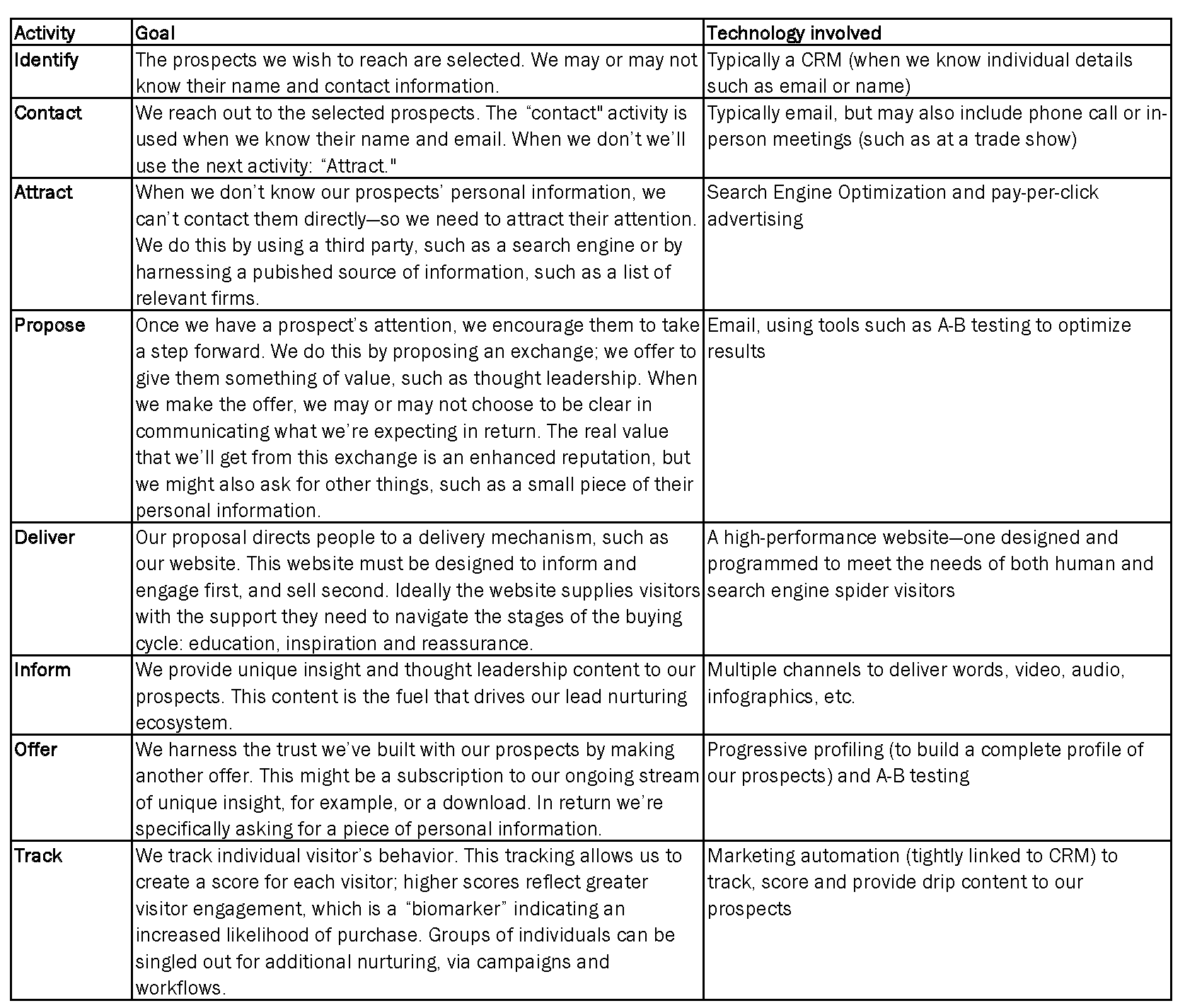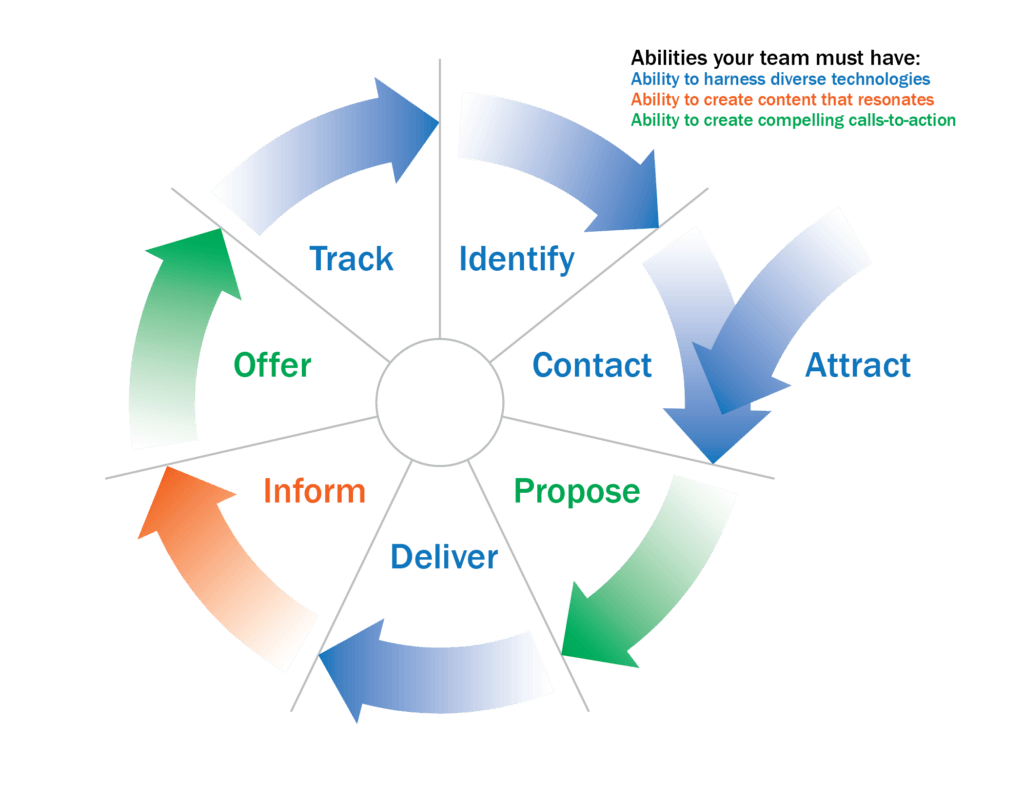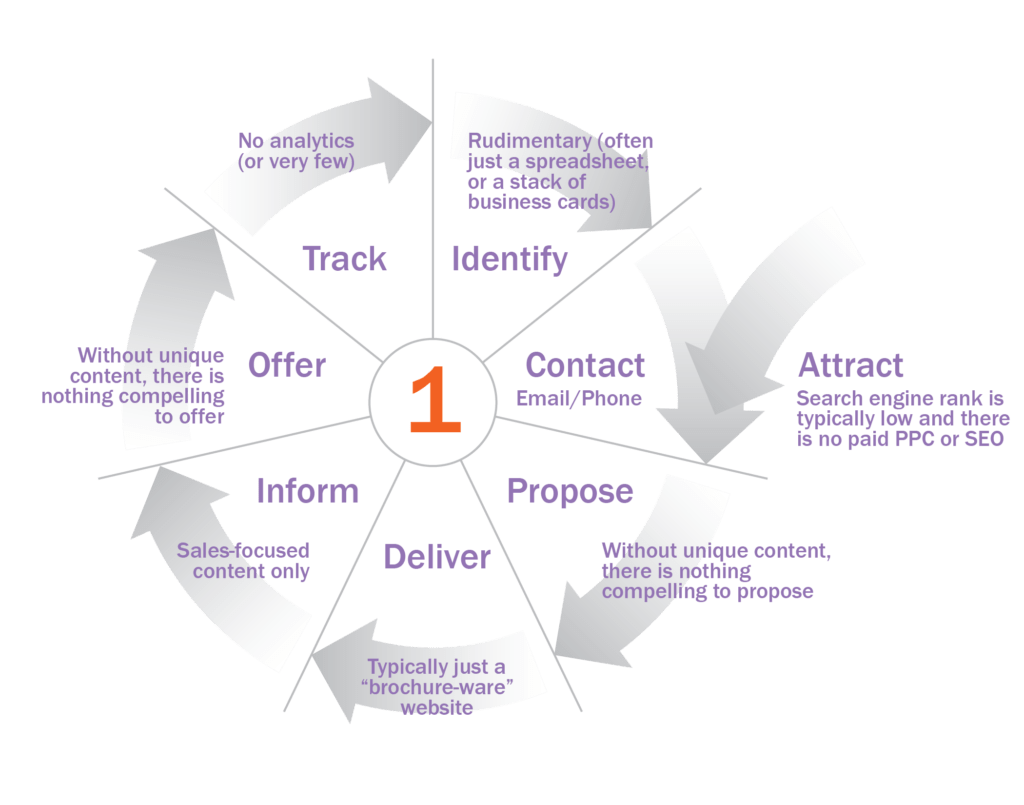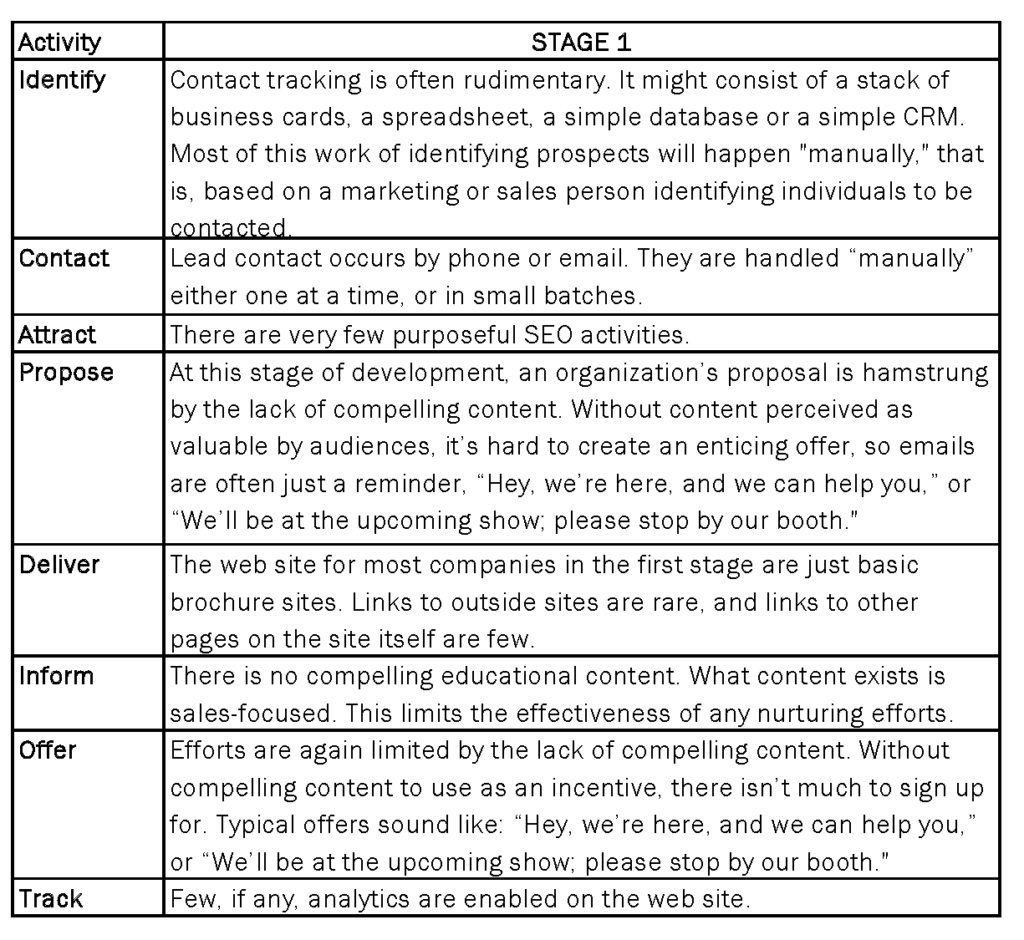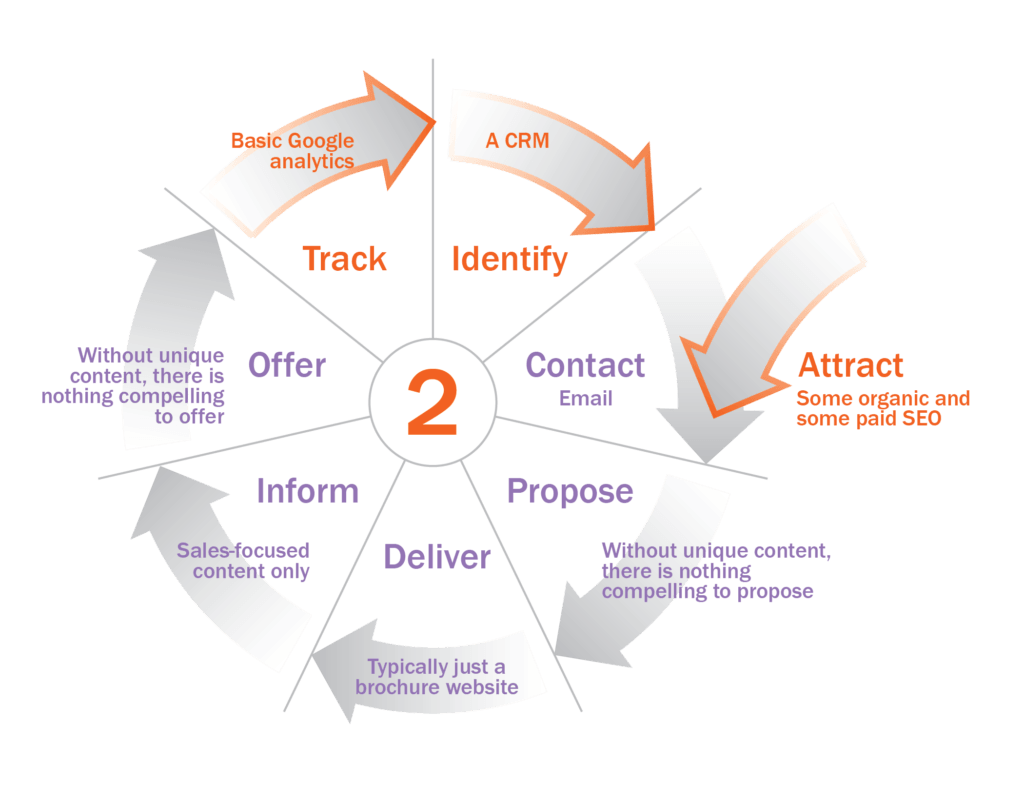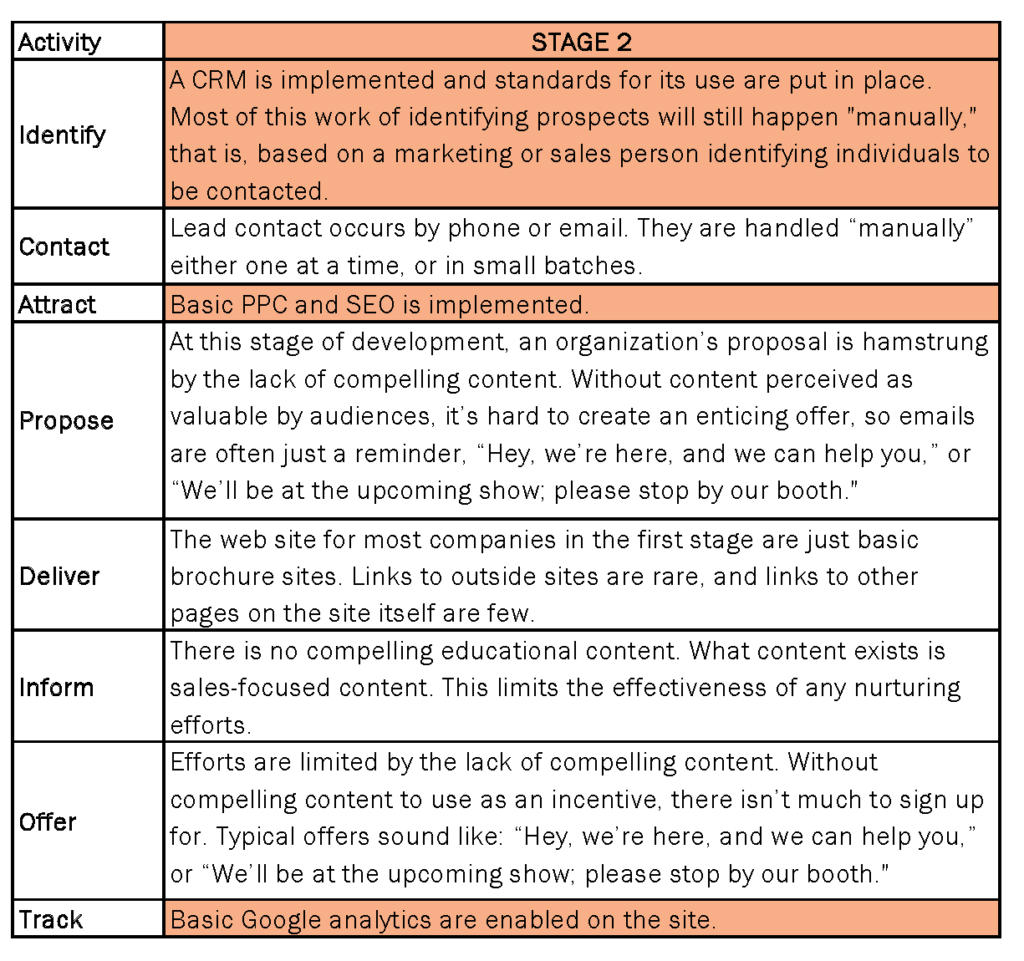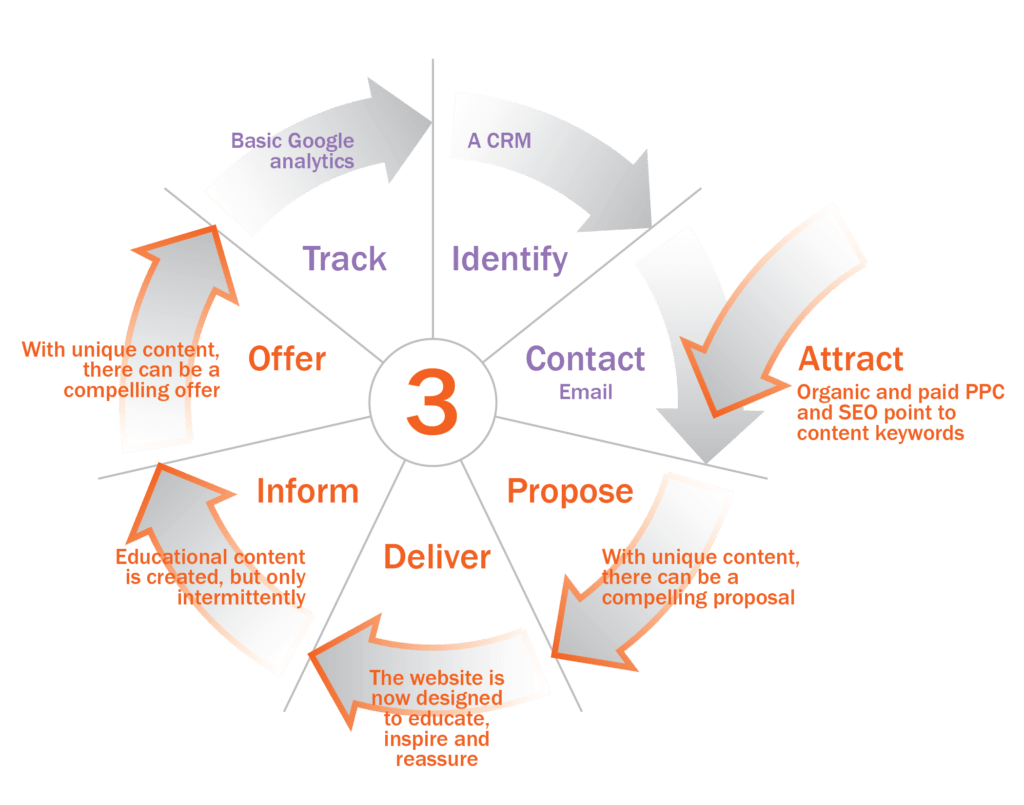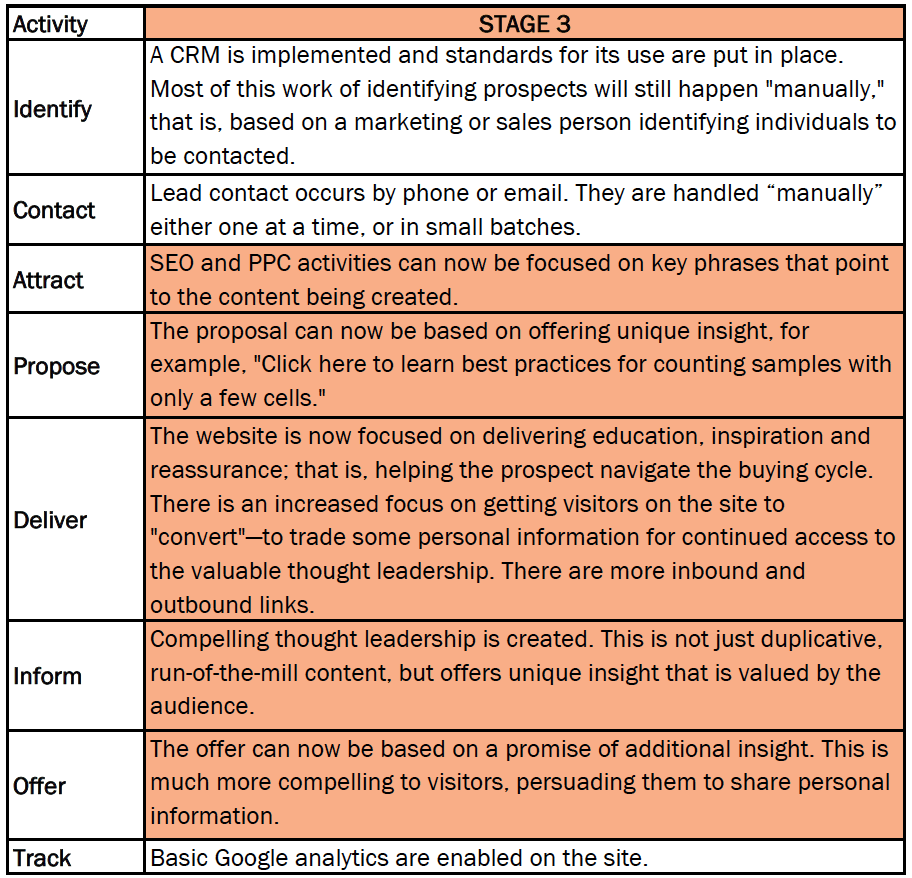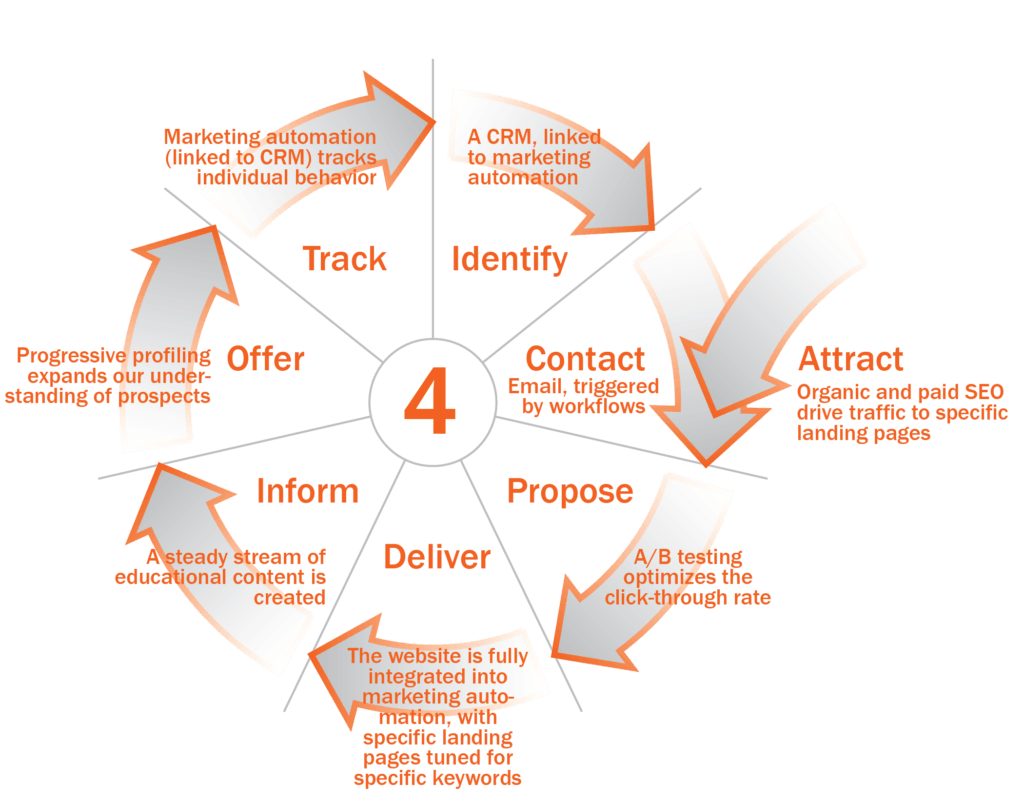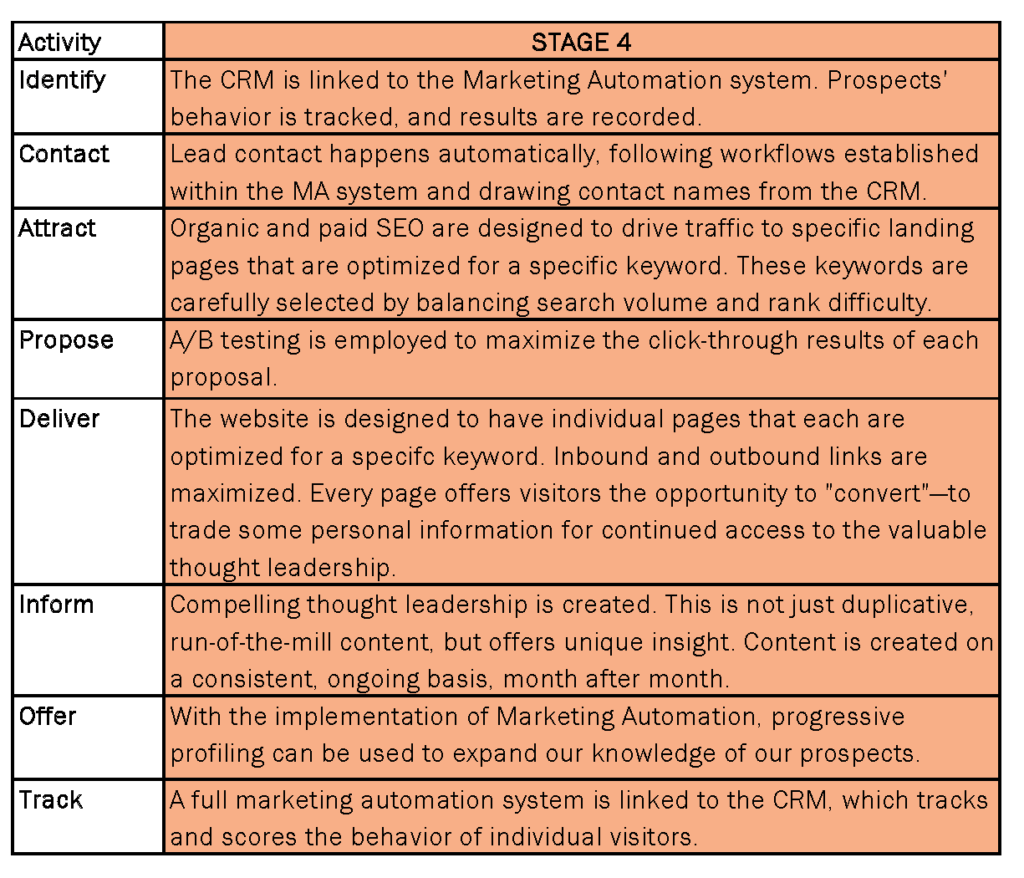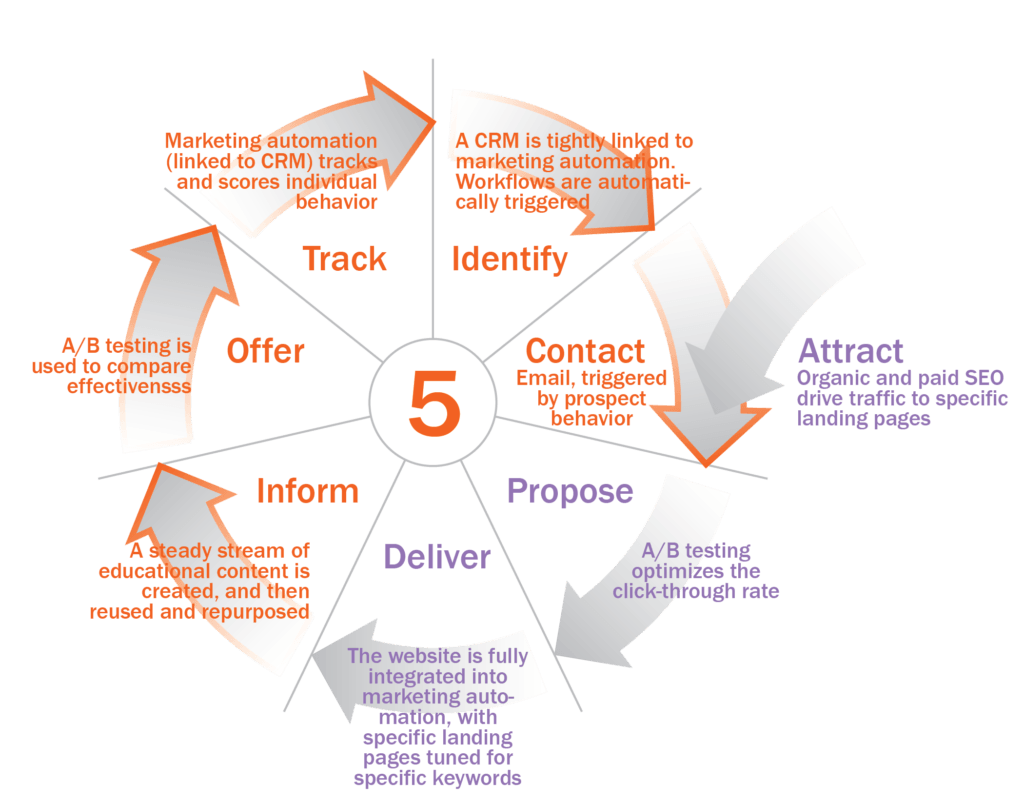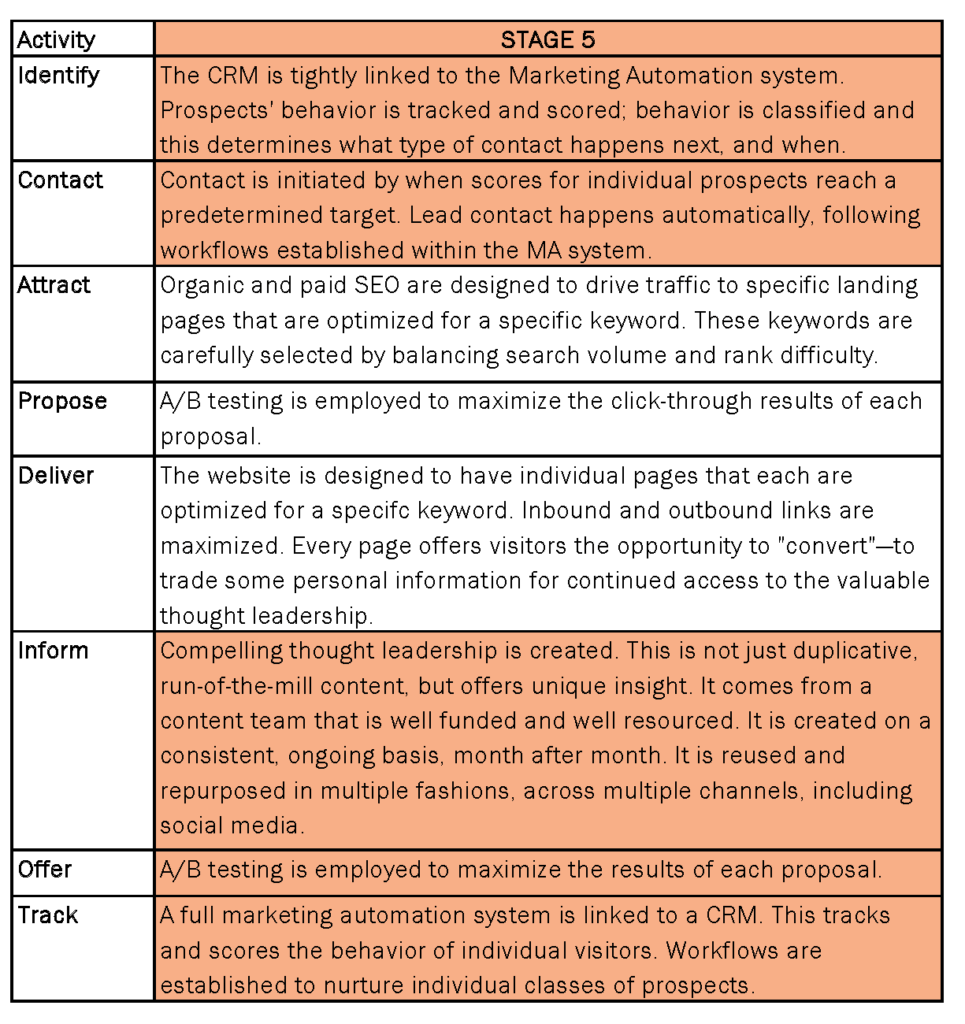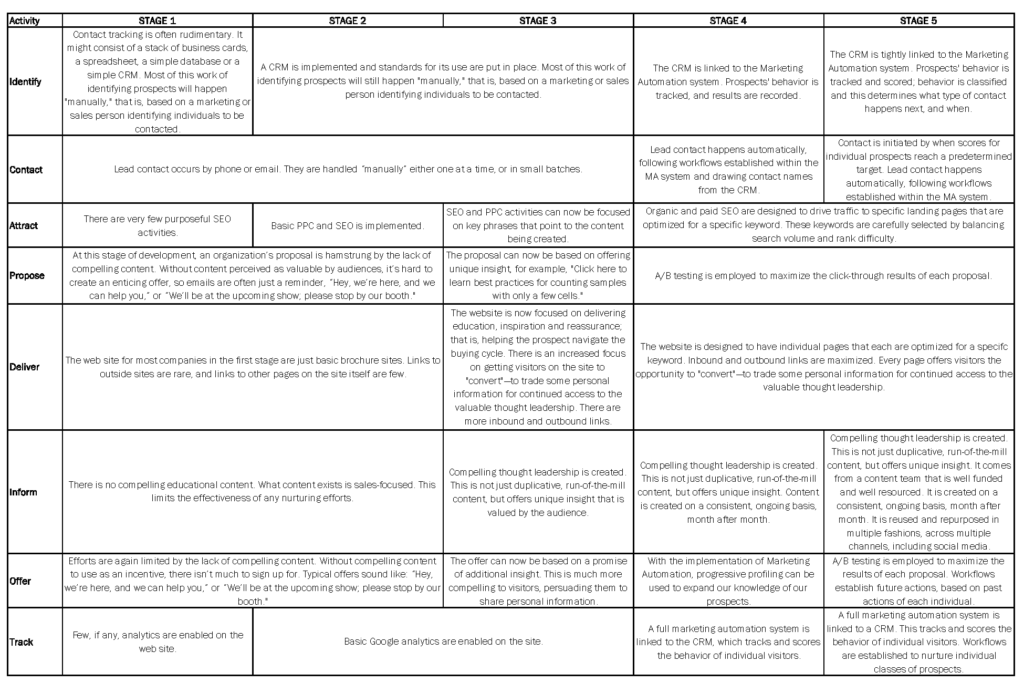Part 4: Developing Your Lead Nurturing Efforts in the Life Sciences
By David Chapin
SUMMARY
VOLUME 8
, NUMER 7
In recent issues I’ve explored lead nurturing in B2B life science marketing, including why we should nurture our life science prospects and the eight different activities involved in lead nurturing. In this issue I’ll highlight the skills and abilities a marketing team must possess to maximize their lead nurturing efforts, and describe the evolution in lead nurturing activities that a typical life science organization undergoes. There are five stages of this lead nurturing evolution—from basic and piecemeal to comprehensive and strategic. I’ll discuss the tools and technology that are involved in each stage. In a future issue, I’ll share an assessment you can use to determine where you are on this evolutionary path. With this knowledge in hand, you’ll be able to determine where you should focus to improve your lead nurturing efforts.
The activities involved in lead nurturing in the life sciences.
As I discussed in the last issue, a high-performance lead nurturing ecosystem has eight main activities. Seven of them form a cycle, and the eighth is one way that life science prospects are attracted to and enter the lead nurturing cycle. We can begin the cycle anywhere, but it makes the most sense to think about the cycle as starting at the top of figure 1, with the activity titled “Identify.”
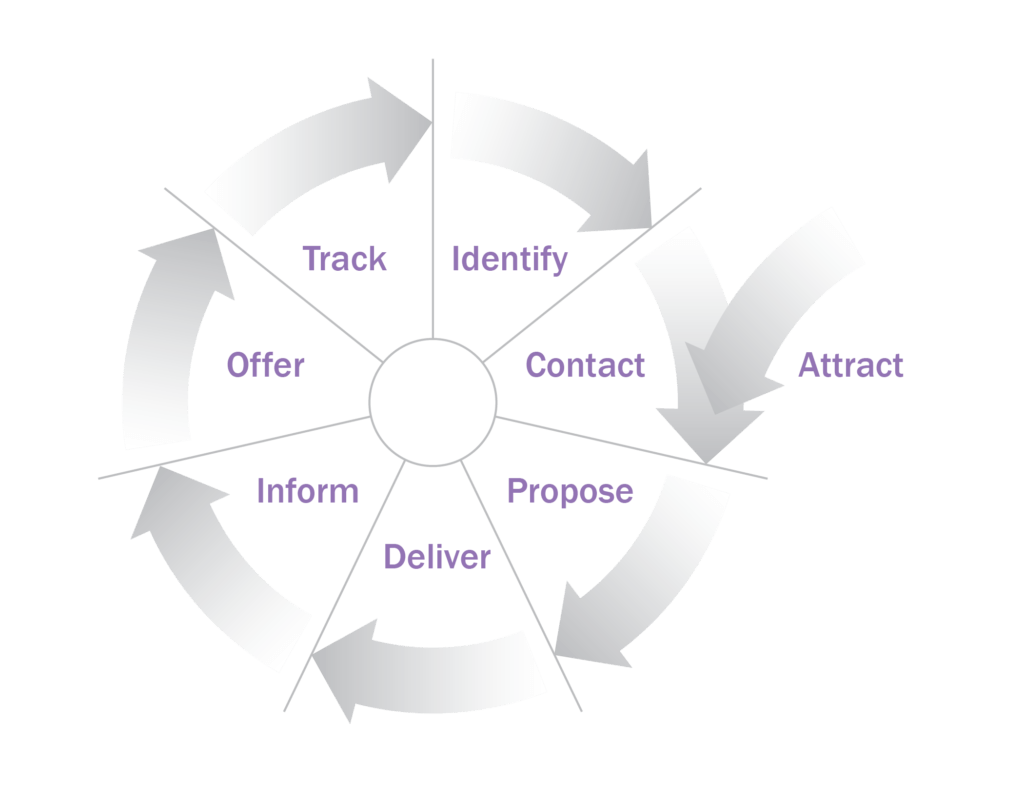 Figure 1. Lead nurturing in the life sciences is composed of eight activities
Figure 1. Lead nurturing in the life sciences is composed of eight activities
A description of these eight activities is included in the table below:
The skills and abilities needed to build a lead nurturing ecosystem in the life sciences.
Your life science marketing team must have three sets of diverse skills and abilities if you are going to successfully build a high-performance lead nurturing ecosystem.
Skill Set 1: The ability to harness a wide array of diverse and rapidly changing technologies.
This is most useful in the following activities:
- Identify
- Attract
- Contact
- Deliver
- Track
Skill Set 2: The ability to create content that resonates with your life science prospects.
This includes the ability to understand the unique challenges that your life science prospects are facing, the ability to develop insight into the optimum solutions, and the ability to create content that expresses this insight in a way that is compelling to both prospects and search engine spiders. This is most useful in the following activity:
- Inform
Skill Set 3: The ability to create compelling calls-to-action (based on an understanding of the psychology of the exchange implicit in any call-to-action) and express them in ways that motivate your life science prospects to do something specific. This is most useful in the following activities:
- Propose
- Offer
Figure 2. A diverse array of abilities is required to create a high performance lead nurturing ecosystem in the life sciences.
The evolution of a lead nurturing ecosystem in the life sciences.
Once the magnitude of a full-blown nurturing effort becomes clear, some people get discouraged. There is a lot to accomplish, and a lot that can go wrong, isn’t there? But don’t get discouraged. Life science organizations don’t implement these eight activities all at once or with equal emphasis. They begin with some of the basic ones and progress through an evolutionary process, driven by the changing needs of their prospects and their sales and marketing teams. I’ll describe the different stages in a typical life science organization’s evolution. As we discuss each stage, see if you can identify the one that most closely matches your organization’s current level of lead-nurturing maturity. Then by looking at the next stage, you’ll have a good road map for how you can advance your lead nurturing efforts.
Stage 1 in the evolution of lead nurturing programs in the life sciences.
When life science organizations are first starting up, their marketing efforts are often quite rudimentary, as shown in figure 3. This is understandable, because most startup organizations in the life sciences need immediate revenue and therefore put their efforts into sales, not marketing.
Figure 3. Stage 1 in the evolution of lead nurturing efforts. Organizations with unsophisticated lead nurturing and lead generation ecosystems rely more on sales than on marketing efforts. Since the content in this case is mostly promotional, little actual nurturing can occur beyond what a salesperson can accomplish manually on the phone or with email.
The defining factor in this stage is a focus on sales activities, with content that is sales-focused and a website that is essentially a basic brochure. Salespeople who work for life science organizations in these situations have quite a challenge. The only content available to nurture the prospects who are not yet ready to buy is promotional, not educational. It might cover features (“speeds and feeds”), or it might even be crafted to discuss benefits, but it is still sales focused. As we saw in our previous analysis of how people buy, those in early stages of the buying cycle need education. So content that is sales-focused will not be effective; it falls on deaf ears. Sending life science prospects one sales brochure after another won’t nurture them; it will only annoy them.
The table below has more detail on the lead nurturing activities in this first stage.
Stage 2 in the evolution of lead nurturing programs in the life sciences.
As life science organizations grow their list of contacts and leads, there’s often pressure from sales management to organize sales efforts and maximize sales results. And as web traffic increases, important questions are (or should be) raised: Who are these visitors? Where are they coming from? How do we increase web traffic even more? All of this drives marketing teams to begin to pay attention to SEO, and implement basic pay-per-click ad campaigns. To measure results, basic Google analytics are implemented on the site.
Figure 4. Stage 2 in the evolution of lead nurturing efforts. The items shown in orange in this figure are the focus at this stage, because as life science organizations mature, they typically first turn their attention to technology that can provide increased visibility into basic nurturing activities.
The defining factor in stage 2 is an increased focus on basic technology to identify, attract and track prospects. Which is a big improvement. But being able to crunch more numbers only goes so far. Without a steady stream of compelling content, routine lead nurturing in the life sciences is very difficult and is limited to systems that rely heavily on manual processes focused on one individual prospect at a time.
The lead nurturing activities used in this second stage are described in the following table. Note that many—but not all—of the activities are the same as in the first stage. Those activities that have been changed are highlighted in orange in both the figure above and in the table below, so you can see which activities are usually the focus of a life science organization making the transition from one stage to the next.
Stage 3 in the evolution of lead nurturing programs in the life sciences.
At some point in the development of lead nurturing capabilities, a life science organization recognizes that compelling content is needed to nurture their leads. Many events can spur this recognition. For example, the number of contacts being tracked might grow beyond the ability of a sales team to nurture with phone calls alone. Or a close examination of competitors reveals that some (or all!) are producing compelling content. Or the hiring of more sophisticated sales and marketing team members brings a realization that prospects can remain anonymous throughout much of the sales process, so content is needed to nurture those life science prospects who choose to remain in the shadows.
Whatever causes the “light bulb” moment, the organization now sees that their prospects need nurturing through education. So they initiate the process of creating content. This shift in behavior is accompanied by many other changes. The website pivots to become more of a content delivery mechanism, rather than just a brochure site. The focus becomes more educational. Calls to action now offer prospects the chance to convert—provide some of their personal information in exchange for access to valuable insight or thought leadership. Search engine optimization (SEO) and pay-per-click (PPC) activities related to the content being created are utilized to drive traffic to the site. The activities shown in orange in figure 5 show the new focus at this stage of lead nurturing evolution.
Figure 5. Stage 3 in the evolution of lead nurturing efforts. At this stage, the creation of content opens up many possibilities for the increased effectiveness of lead nurturing activities. The items shown in orange in this figure are the focus of this stage and represent a significant change from the previous stage.
The defining factor in this stage is the creation of unique life science content and a focus on its use in nurturing prospects. The existence of this content means that two activities (Proposal and Offer) can now put forward an exchange that offers real value for a prospect.
As above, some of the activities are the same as in the previous stage; those activities that have been changed are now highlighted in orange.
Stage 4 in the evolution of lead nurturing programs in the life sciences.
Take a quick look at figure 6. Notice anything?
Figure 6. At the fourth stage of lead nurturing evolution, the implementation of marketing automation changes every activity in the lead nurturing cycle. Every item is orange, indicating a change from the previous stage.
It’s hard not to see that every activity in this stage is orange—that is, every activity has undergone significant change from the previous stage of lead nurturing evolution. What’s driving this shift? The implementation of marketing automation (MA) is the major difference between stages 3 and 4. And with the implementation of marketing automation, many other changes occur. For example, linking MA to CRM allows increased sophistication in three major activities: Contact, Propose and Offer.
The changes in this stage of lead nurturing evolution are shown in the (again, all orange) table below.
Stage 5 in the evolution of lead nurturing programs in the life sciences.
This is the final stage in the evolution of lead nurturing efforts in the life sciences. Actually, that’s incorrect; stage 5 is just the final stage in my classification of lead nurturing efforts. Marketing teams can (and should!) continue to expand their knowledge and increase the sophistication of their lead nurturing efforts, of course; but if your team has made it this far, congratulations. Your marketing and lead nurturing efforts will be generating a steady stream of marketing-qualified leads.
Figure 7. At the fifth stage of lead nurturing evolution, everything is in place to realize the benefits of having created a highly effective lead nurturing engine in the life sciences. But this engine requires a steady stream of fuel: unique, valuable thought leadership and insight. The items shown in orange in this figure are the areas of change from the previous stage.
This stage is focused on maximizing the results that marketing automation (MA) can provide. MA is the core of a robust lead nurturing and lead generation engine in the life sciences. This engine runs on a high-octane fuel: unique, valuable, life science content. The continuous demand for content requires that marketing teams become much more attuned to audiences’ educational needs, and much more sophisticated in reusing and repurposing content.
The activities involved in this final stage of lead nurturing evolution in the life sciences are shown in the table below.
The major transitions between the different stages in lead nurturing in the life sciences.
What happens when we take a broad look at all of the stages in the evolution of a life science organization’s lead nurturing efforts? We can start to see the inflection points that typically drive change and advancement.
In the transition from stage 1 to 2, the focus is on using technology to improve the performance of the web site. Unfortunately, a web site at this stage has very little content that is useful for nurturing life science clients, so organizations in stages 1 or 2 are not very effective at nurturing their prospects.
In the transition from stage 2 to 3, organizations realize that content is the fuel that will drive a lead nurturing engine, so some content is created. Unfortunately, out the outset most content efforts are intermittent and have a hard time gaining momentum (because the people implementing them don’t yet understand the scope of what’s involved).
In the transition from stage 3 to 4, organizations implement marketing automation. This implementation drives the most significant change in a life science organization’s lead nurturing efforts.
In the transition from stage 4 to 5, organizations come to terms with the interplay between maintaining a fully functioning marketing automation system and fueling this system with a steady stream of unique, valuable content. This is the point at which lead nurturing systems are able to support large life science sales teams and supply a steady stream of inbound leads.
As I hope is clear, two of the transitions between stages are larger, and potentially more challenging, than the others. The first is the transition between stage 2 and 3, where content begins to be created. The creation of content requires that marketing teams begin to think like publishers, rather than advertisers. The second major transition is between stage 3 and 4, where marketing automation requires the development of a systematic and program-oriented approach to nurturing clients.
These two transitions can be difficult for life science marketing teams. Consequently, many organizations get stuck, unable to make the transition between stages 2 and 3, or between stages 3 and 4.
Lead nurturing and inbound marketing in the life sciences.
I would like to make two additional key points about this model of lead nurturing in the life sciences. The first is that the lead nurturing cycle described here involves the exact same activities as an inbound marketing initiative. When we go through the entire cycle and use the Attract activity rather than the Contact activity, the result is that anonymous prospects notice our marketing efforts and (we hope) respond to our Call to Action—clicking through to read our content—and give us some information in exchange for this insightful information. In this case we’ve identified a previously anonymous prospect and converted them to a known contact; that is, we’ve generated a lead using an inbound marketing initiative.
The importance of content in life science lead nurturing.
The second key point is that the fuel that powers this entire lead nurturing system in the life sciences is Content. That really can’t be stressed enough. When the lead generation and nurturing engine is working at full velocity, it can generate a steady stream of life science leads, each being nurtured along from one stage in the buying cycle to the next. It’s possible to accomplish this using only minimal technology, or using hundreds of thousands of dollars of technology. But regardless of the level and cost of the tools being used, any lead nurturing (or lead generating) effort cannot survive for long without a steady stream of unique, valuable, insightful content. Of course, knowing this doesn’t make it any easier to generate that content. Many life science organizations have trouble creating compelling content, for a wide variety of reasons. If you’d like to read more about the difficulties life science marketing organizations face in content marketing—and ways to overcome them—you can do so here, here, here, here and here.
Conclusion.
Organizations go through distinct transitions from one stage of lead nurturing prowess to another. In this whitepaper, I’ve outlined the 5 different stages, and discussed the transition from one to the next. If you’ve been paying attention, you’ve likely been able to identify your own organization’s position along this evolutionary path. Which means you now have a roadmap for your lead nurturing efforts. By carefully examining the path to and requirements for the next stage, you’ll gain insight into how you can most effectively advance your life science marketing efforts.
The Marketing of Science is published by Forma Life Science Marketing approximately ten times per year. To subscribe to this free publication, email us at info@formalifesciencemarketing.com.
David Chapin is author of the book “The Marketing of Science: Making the Complex Compelling,” available now from Rockbench Press and on Amazon. He was named Best Consultant in the inaugural 2013 BDO Triangle Life Science Awards. David serves on the board of NCBio.
David has a Bachelor’s degree in Physics from Swarthmore College and a Master’s degree in Design from NC State University. He is the named inventor on more than forty patents in the US and abroad. His work has been recognized by AIGA, and featured in publications such as the Harvard Business Review, ID magazine, Print magazine, Design News magazine and Medical Marketing and Media. David has authored articles published by Life Science Leader, Impact, and PharmaExec magazines and MedAd News. He has taught at the Kenan-Flagler Business School at UNC-Chapel Hill and at the College of Design at NC State University. He has lectured and presented to numerous groups about various topics in marketing.
Forma Life Science Marketing is a leading marketing firm for life science, companies. Forma works with life science organizations to increase marketing effectiveness and drive revenue, differentiate organizations, focus their messages and align their employee teams. Forma distills and communicates complex messages into compelling communications; we make the complex compelling.
© 2024 Forma Life Science Marketing, Inc. All rights reserved. No part of this document may be reproduced or transmitted without obtaining written permission from Forma Life Science Marketing.
